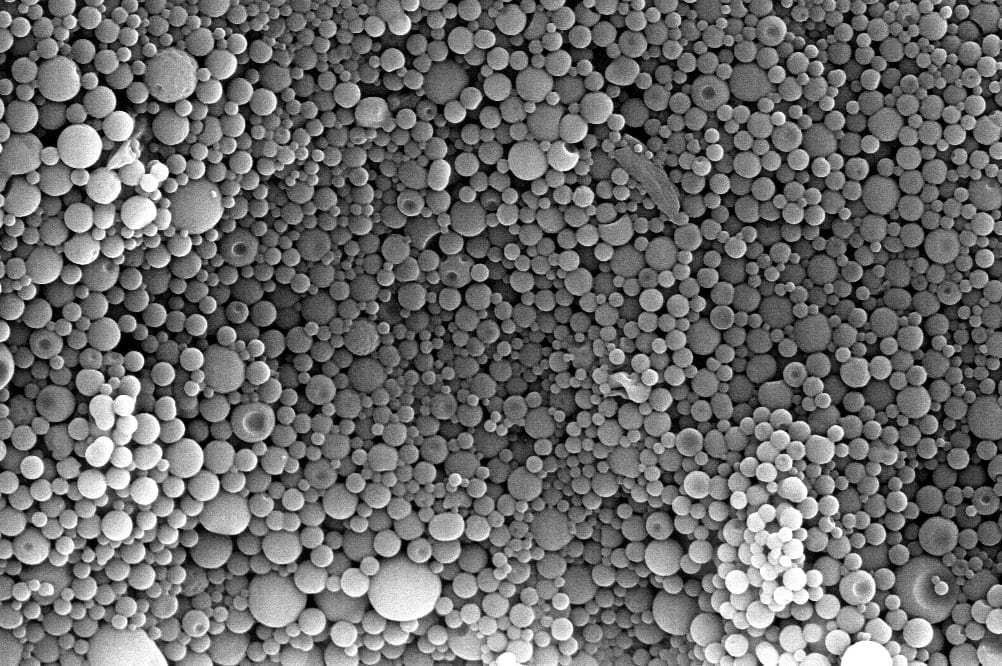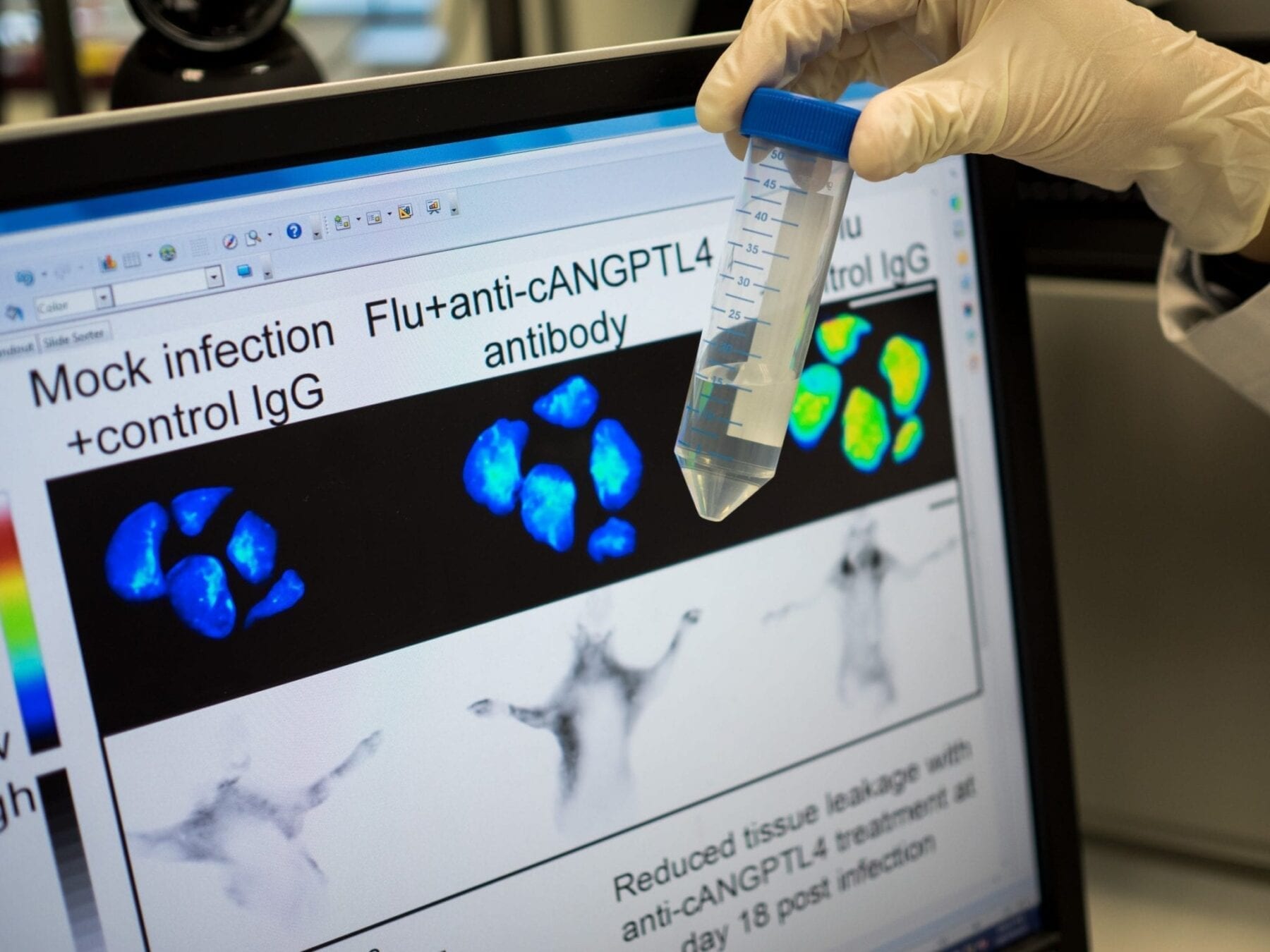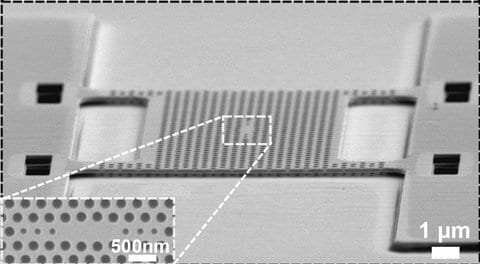
For many of us, a flu shot is a fall routine. Roll up a sleeve, take a needle to the upper arm and hope this year’s vaccine matches whichever viruses circulate through the winter.
The most common method to make that vaccine is now more than 70 years old. It requires growing viruses in special, pathogen-free chicken eggs. It’s not a quick and easy manufacturing process. And, at best, it provides incomplete protection.
Researchers from Iowa State University, the University of Iowa and the University of Wisconsin-Madison – all of them affiliated with Iowa State’s Nanovaccine Institute – are working together to develop and test what they think could be a better way to fight the flu.
“What we’re doing is a completely new approach,” said Thomas Waldschmidt, the associate director of the Nanovaccine Institute, the Clement T. and Sylvia H. Hanson Chair in Immunology and a professor of pathology at Iowa. “This is a completely different ball game.”
What the researchers are doing is loading synthesized influenza proteins into nanoparticles. Those nanoparticles are about 300 billionths of a meter across and are made from biodegradable polymers. The nanoparticles are incorporated into a nasal spray and delivered with a sniff. Based on preliminary studies, researchers believe the nanovaccine will activate both kinds of immune cells (T cells and B cells) and provide protection in the upper airway (the nose, throat and voice box) and the lower airway (the windpipe and lungs).
All of that could mean better flu protection than today’s typical flu shot.
Looking for more complete protection
The National Institutes of Health is supporting the study of a flu nanovaccine with a five-year, $2.8 million grant.
Kevin Legge, an associate professor of pathology at Iowa, is leading the study. The research team also includes Waldschmidt; Balaji Narasimhan, the director of the Nanovaccine Institute and an Anson Marston Distinguished Professor in Engineering and the Vlasta Klima Balloun Chair in Chemical and Biological Engineering at Iowa State; and Thomas Friedrich, an associate professor of pathobiological sciences at Wisconsin.
So far, the researchers have tested a flu nanovaccine on mice, ferrets and pigs. The current study also calls for tests on monkeys.
Legge said today’s flu vaccines activate B cells and their production of antibodies. Those antibodies circulate throughout the body and attack viruses by binding to them, coating them and disabling them. Antibodies also signal other defensive cells to attack and destroy the virus.
Rodent studies have shown that the flu nanovaccine drives B cell as well as T cell activity, Legge said. T cells fight disease by attacking cells that have been infected by a virus.
Activating both B cells and T cells provides “a greater level of protection,” Legge said. “This is a more complete, robust response to vaccination.”
Legge and Narasimhan said the nanovaccine also seems to be better at building immunity in the lungs than current flu shots or the flu mist that was common several years ago and is no longer recommended by the Centers for Disease Control and Prevention.
Narasimhan said there are other advantages to a flu nanovaccine: it can easily be loaded with proteins synthesized from many different types of flu, it can be modified and produced quickly (the researchers call it “plug-and-play” technology) and it can be safely stored for long periods at room temperature.
The technology, he said, has the potential to check all the boxes for a better flu vaccine.
Learning the mechanisms, testing different types
But there’s more to learn about a flu nanovaccine before it’s available every fall.
Legge and Waldschmidt said they want to understand how, exactly, the nanovaccine provides protection from the flu. They also want to further define how the vaccine activates an immune response from B cells and T cells.
They’ll also study nanovaccine effectiveness against different types of influenza, including deadly strains such as H5N1, or bird flu.
“We want to confirm that this vaccine platform will work with any influenza payload,” Waldschmidt said.
Narasimhan said it’s also important to find just the right size of nanoparticles for a flu nanovaccine.
“It’s the ‘Goldilocks problem,’” he said. “Too big is not good and too small is not good. We’re looking for just right.”
And, the project will include tests of the flu nanovaccine on some of the monkeys studied by Friedrich at Wisconsin.
It’s important to study the nanovaccine in monkeys because their respiratory tracts and immune systems are similar to those in humans, Friedrich said.
“Monkeys are there to give us confidence that what is found in mice studies is truly relevant to humans,” he said. “And if problems are found in monkey studies, the vaccine can be tweaked to make it more effective before it goes to human trials.”
Friedrich also said that the monkeys used in this study are expected to recover from any illness and will be used in other studies.
Learn more: Novel Nanovaccine Could Fight Off Flu
The Latest on: Flu nanovaccine
[google_news title=”” keyword=”flu nanovaccine” num_posts=”10″ blurb_length=”0″ show_thumb=”left”]- Cold and Flu Newson May 6, 2024 at 4:59 pm
Mar. 26, 2024 — Simply asking patients to get the flu vaccine, and combining it with helpful video and print messages, is enough to persuade many who visit emergency departments to roll up their ...
- Bird Fluon May 3, 2024 at 10:25 am
The third person ever recorded to have contracted H3N8 bird flu has died in China, with all three infected people having been exposed to live poultry. In the third ever case of a human infection ...
- Influenza Newson May 1, 2024 at 5:00 pm
Mar. 1, 2024 — Researchers have identified antibodies targeting a hard-to-spot region of the influenza virus, shedding light on the relatively unexplored 'dark side' of the neuraminidase (NA ...
- Do you own chickens? Here's how to protect your flock from bird flu outbreakson May 1, 2024 at 4:04 pm
As concerns about the spread of bird flu continue to grow in the wake of ongoing outbreaks, U.S. officials have are working to keep the virus at bay in commercial poultry and dairy settings.
- Bird flu testing shows more dairy products are safe, US FDA sayson May 1, 2024 at 11:39 am
CHICAGO, May 1 (Reuters) - Preliminary results of tests on additional dairy products show that pasteurization inactivates the bird flu virus, the U.S. Food and Drug Administration said on Wednesday.
- How humans can and can’t catch bird fluon May 1, 2024 at 4:30 am
Scientists are on alert for changes in the H5N1 or bird flu virus that could signal it is adapting to spread among humans. The virus has caused serious, sometimes fatal, infections among people ...
- Bird Flu Is Spreading. Did We Learn Nothing From Covid?on May 1, 2024 at 1:08 am
[MUSIC PLAYING] Bird flu is circulating in the United States among poultry, and also among cows. And so far, there has been one known human case. archived recording 1 For the second time ever in ...
- Amid bird flu spread, experts reveal if it's safe to drink milk: 'Indirect concern'on April 26, 2024 at 5:16 pm
Traces of bird flu have been detected in pasteurized milk — leaving many people wondering if it’s safe to drink. The U.S. Food and Drug Administration (FDA) released a notice on Thursday ...
- Long flu season winds down in USon April 26, 2024 at 8:03 am
NEW YORK (AP) — The U.S. flu season appears to be over. It was long, but it wasn’t unusually severe. Last week, for the third straight week, medical visits for flu-like illnesses dipped below ...
- 'Unprecedented': How bird flu became an animal pandemicon April 25, 2024 at 5:00 pm
Bird flu is decimating wildlife around the world and is now spreading in cows. In the handful of human cases seen so far it has been extremely deadly. The tips of Lineke Begeman's fingers are ...
via Google News and Bing News














